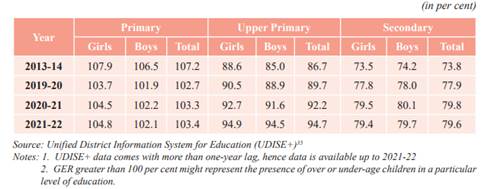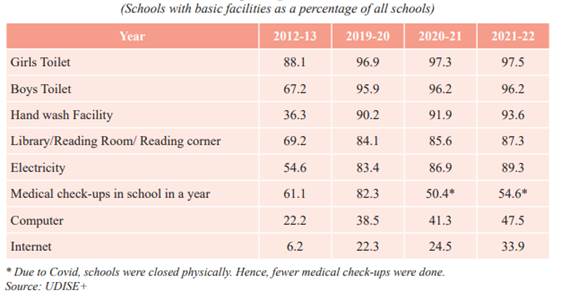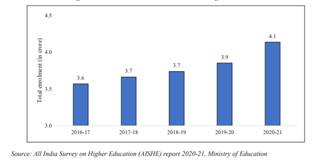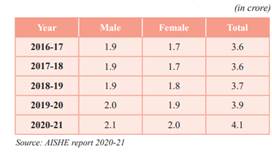The survey states that the standard schooling which is enlisted as Aim 4 underneath UN SDGs (SDG4) goals to ‘guarantee inclusive and equitable high quality schooling and promote lifelong studying alternatives for all’ by 2030. It’s on this context that the Nationwide Training Coverage 2020 was laid down as the primary Training Coverage of the twenty first century, aiming to deal with the various rising developmental imperatives of the nation. The coverage supplied for the revision and revamping of all elements of the schooling construction. The Union Minister for Finance and Company Affairs, Nirmala Sitharaman tabled Financial Survey 2022-23 in Parliament right this moment.
College Enrolment
The 12 months FY22 noticed enchancment in Gross Enrolment Ratios (GER) in colleges and enchancment in gender parity. GER within the primary-enrolment in school I to V as a proportion of the inhabitants in age 6 to 10 years – for ladies in addition to boys have improved in FY 22. This enchancment has reversed the declining tendencies between FY17 and FY19. GER in Higher Major (enrolment in school VI to VIII as a per cent of the inhabitants in age 11-13 years), which was stagnant between FY17 and FY19, improved in FY22. In corresponding age teams in Major and Higher-Major ranges, ladies’ GER is healthier than boys.
College Gross Enrolment Ratios

In FY22, faculty enrolment stood at 26.5 crore kids with 19.4 lakh further kids enrolled in Major to Larger Secondary ranges. Complete enrolment of Youngsters with Particular Wants (CWSN) in FY22 stands at 22.7 lakh as in comparison with 21.9 lakh in FY21, which is a rise of three.3 per cent. The enrolments elevated throughout all ranges viz., Major, Higher-Major, Secondary and Larger Secondary aside from the Pre-Major stage. On the Pre-primary stage, enrolment decreased from 1.1 crore in FY21 to 1.0 crore in FY22. In the course of the 12 months, about 1.0 crore kids had been enrolled in pre-primary, 12.2 crore in Major, 6.7 crore in Higher Major, 3.9 crore in Secondary and a pair of.9 crore in Larger Secondary.
College Drop-out
College dropout charges in any respect ranges have witnessed a gradual decline in recent times. The decline is for each ladies and boys. The schemes similar to Samagra Shiksha, RTE Act, enchancment at school infrastructure and amenities, residential hostel buildings, availability of academics, common coaching of academics, free textbooks, uniforms for kids, Kasturba Gandhi Balika Vidyalaya and the PM POSHAN Scheme play an vital function in enhancing enrolment and retention of kids in colleges.

College dropout charges
College Infrastructure
The schooling infrastructure within the type of colleges, facilities and digitalisation has been steadily promoted together with a give attention to pedagogy. The essential infrastructure amenities in colleges – each by way of the variety of recognised colleges and academics’ availability mirrored within the Pupil-Instructor Ratio, confirmed an enchancment in FY22.
Fundamental amenities in colleges continued to enhance in FY22 over earlier years. Bathrooms (ladies or boys), ingesting water, and hand-washing amenities are actually obtainable in most authorities colleges. Precedence to ingesting water and sanitation in colleges underneath Samagra Shiksha Scheme in addition to Swachh Bharat Mission have been instrumental in offering required assets and creating these property in colleges. Underneath the Data & Communication Expertise (ICT) part of the Samagra Shiksha Scheme, Authorities helps the institution of good school rooms and ICT labs in colleges, together with help for {hardware}, academic software program and e-content for educating.

Enhancing College Infrastructure
The supply of academics, measured by pupil-teacher ratio, an indicator which is inversely associated to enchancment in high quality of schooling, has improved in any respect ranges constantly from FY13 to FY22: from 34.0 to 26.2 at Major, 23.0 to 19.6 at Higher Major, 30.0 to 17.6 at Secondary, and 39.0 to 27.1 on the Larger Secondary stage. The advance within the variety of colleges, academics’ availability, and amenities in colleges is predicted to assist enhance enrolment and cut back dropout charges.
Varied programmes and schemes for college schooling launched throughout FY23 are introduced within the following paras.
PM Faculties for Rising India: The Authorities launched a Centrally Sponsored Scheme (CSS) referred to as PM Faculties for Rising India (PM SHRI) on 7 September, 2022. Underneath the scheme, there’s a provision for organising greater than 14,500 PM SHRI Faculties, over the interval FY23 to FY27 by strengthening the present colleges from these managed by Central Authorities/State/UT Authorities/native our bodies. These colleges will likely be outfitted with fashionable infrastructure and showcase the implementation of the NEP and emerge as exemplary colleges over a time frame, whereas providing management to different colleges within the neighbourhood. Greater than 20 lakh college students are anticipated to be direct beneficiaries of the scheme.
The Nationwide Curriculum Framework (NCF) for Foundational Stage: NCF for Foundational Stage has been launched as the brand new 5+3+3+4 curricular construction which integrates early childhood care and schooling for all kids of ages 3 to eight.
Pilot challenge of Balvatika: With a give attention to growing cognitive, affective and psychomotor talents and likewise early literacy and numeracy for college students within the age teams of three+, 4+ and 5+ years, Mission Balvatika, i.e.,‘Preparatory Class’, was launched in October 2022 in 49 Kendriya Vidyalayas.
– A handbook for Toy-based pedagogy
– Screening instruments (Cellular App) for particular studying disabilities
– Nationwide Credit score Framework
– Strengthening Educating-Studying and Outcomes for States (STARS)
– Vidyanjali (A College Volunteer Initiative): The programme has efficiently managed to affect round 11,34,218 college students throughout the nation.
– Samagra Shiksha Scheme: An overarching programme for the varsity schooling sector extending from pre-school to class XII. The Samagra Shiksha Scheme has been aligned with the suggestions of the NEP 2020 and prolonged from FY22 to FY26.
Larger Training
Variety of Indian Institutes of Expertise (IITs) and Indian Institute of Administration (IIMs), respectively stand at 23 and 20 in 2022 towards 16 and 13 in 2014. The energy of Indian Institutes of Data Expertise (IIITs) is 25 in 2022 towards 9 in 2014.
The entire enrolment in larger schooling has elevated to almost 4.1 crore in FY21 from 3.9 crore in FY20. Since FY15, there was a rise of round 72 lakh in enrolment (21 per cent). The feminine enrolment has elevated to 2.0 crore in FY21 from 1.9 crore in FY20.
Complete College students’ Enrolments in Larger Training College students’ Enrolment in Larger Training


The enrolment in Distance Training is 45.7 lakh (with 20.9 lakh females), a rise of round 7 per cent since FY20 and 20 per cent since FY15. The GER in larger schooling, primarily based on 2011 inhabitants projections (revised), was recorded at 27.3 per cent in FY21, which is an enchancment from 25.6 in FY20. GER for males elevated from 24.8 in FY20 to 26.7 in FY21 whereas GER for females has additionally proven enchancment from 26.4 to 27.9 throughout the identical interval.
The entire variety of school/academics in Larger Training is 15,51,070 of which about 57.1 per cent are male and 42.9 per cent are feminine.
The survey appreciated the varied initiatives for Larger schooling together with Analysis & Improvement Cell (RDC) in Larger Training Establishments, tips for pursuing two tutorial programmes concurrently, curiosity subsidy on schooling mortgage.
The Survey additionally mentions a few three-day Akhil Bharatiya Shiksha Samagam organised at Varanasi on 7-9 July 2022 by the Ministry of Training in affiliation with the UGC and Banaras Hindu College. The occasion introduced collectively over 300 Vice Chancellors and Administrators from private and non-private universities, educationists, policymakers, as additionally business representatives to deliberate on how the implementation of NEP 2020 might be taken additional throughout the nation after profitable implementation of a number of initiatives within the final two years. The summit supplied a platform for thought-provoking discussions that helped articulate the roadmap and implementation methods, foster data alternate, construct networks by way of interdisciplinary deliberations, and talk about challenges being confronted by academic establishments and articulate options.
(PIB)


